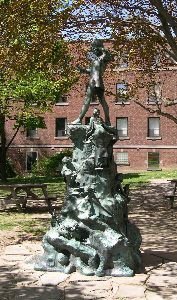Once standing at the corner of St. Clair Avenue and Avenue Road, the writer noted a unexpected number of links to other parts of the world. He counted eight starting with Amsterdam Park and, knowing of others in the area, made this a theme for a walk through Deer Park and now a web page.
Amsterdam Square: While this park was established in the 1920s, it received its name only in 1974, when Toronto and Amsterdam became “twin cities.” www.amsterdam-netherlands.info/.
H. H. Williams, a very successful Realtor who lived nearby, donated the land for this park and the fountain in it. He went to Europe in search of a suitable fountain for the park and found what he wanted, a wall fountain near the entrance to the Peace Palace at The Hague, The Netherlands. The Peace Palace had been built as a meeting place for all nations, in the hope of preventing any further world-wide wars.

Williams had a replica built here which was unveiled on September 14, 1929, the same day that the Peter Pan statue was dedicated across the road. The fountain has recently been restored. The fine male Ginkgo represents a link with the City of Beijing which like Toronto has many Ginkgo trees planted along its streets. www.china-window.com/beijing/beijing.html
Across the road, on the north-west corner of Avenue Road and St. Clair, is Glenn Gould Park, another small park, recently been named in honour of the internationally famous pianist, Glenn Gould. www.glenngould.com. Mr Gould lived nearby in an apartment at 110 St Clair Ave. W. In this park is an copy of the well known statue of Peter Pan in Kensington Gardens, London England, www.britannia.com/history/londonhistory installed by the College Heights Association in 1929. Donald Jones has written about both sculptures in “Fifty Tales of Toronto.”

Statue of Peter Pan in Glenn Gould Park.
Just north of Amsterdam Square, at # 555 Avenue Road, is the house that George Howard Ferguson. Premier of Ontario, built in 1930. It is now the Consulate General of the Republic of Korea, (capital Seoul). www.korea.net.
Until recently, there was a Bank of Montreal branch at the SE corner. On the south side of St. Clair a little to the east is the headquarters of Imperial Oil, at least for now. Imperial Oil Limited announced on September 29, 2004 that it will be relocating its head office from Toronto to Calgary. The move was expected to be completed August 2005. www.calgary.ca
Nearby churches include: Deer Park United Church, which was Presbyterian prior to church union, and The First Unitarian Congregation. The Presbyterian denomination started in Edinburgh, Scotland. The Unitarian movement has its roots in Transylvania and Poland.
This area was originally in York Township, named by Colonel John Graves Simcoe for Frederick, Duke of York. The City of York was the location where Constantine was declared Emperor of Rome. Constantine moved the Imperial Capital to Bysantium, which became known as Constantinople and now Istanbul.
If we broaden the area included, we find more.
Walking down Avenue Road we pass Balmoral Avenue, Farnham
Avenue (link to house) and Clarendon Avenue. Clarendon was the
site of the Assize of 1166, an important step in the evolution of our judicial
system. www.fordham.edu/halsall/source/aclarendon.html
At the top of the Avenue Road Hill or Iroquois Shore Bluff is Oaklands, built in 1860, by John Macdonald, a major dry goods wholesaler, enlarged by Mary McCormick of Chicago, heiress to the McCormick fortune, in the early 20th century and now De La Salle Oaklands College. The outlet of Lake Iroquois was near Rome New York to the Hudson River, which enters the Atlantic Ocean where the great City of New York stands now.
From here, walking over to Poplar Plains Crescent, we pass the site of Rathnelly, the great house of William McMaster, which stood on the hill just east Poplar Plains Road. McMaster was one of Victorian Toronto’s most successful businessmen and philanthropists. He was a fervent Baptist and a generous benefactor, contributing to the Baptist college, McMaster Hall, and the Jarvis Street Baptist Church. McMaster Hall, the building, is now the Royal Conservatory of Music, but the college was moved to Hamilton and is now McMaster University.
Quite a few of Toronto’s trees can be linked to other cities and countries: Horse Chestnut comes from the Balkans.
The Lindens remind us of Berlin’s avenue Unter den Linden.
Mulberry reminds us of the silk road and its eastern terminus in China’s ancient capital Xien.
Black Walnut has ties with Kitchener, Ailanthus with Indonesia and Black Locust with Appalachia & the Ozarks. And of course there are Kentucky Coffee Trees and Siberian Elm.
Norway Maple, Norway Spruce and Scotch Pine could be linked to specific cities; however, they are important timber trees that grow in many of the northern European countries, so maybe they should be linked to Brussels, seat of the European Parliament, Europe has distinctly fewer native timber trees than North America; see “The Story of the Trees” in the series of pages on the glaciation.
This could go on and on.
